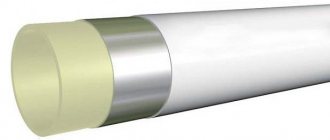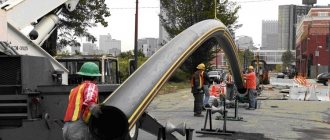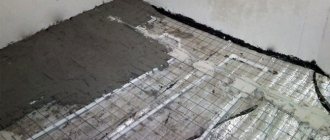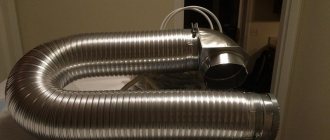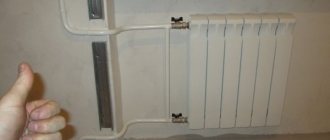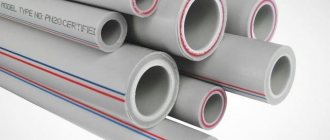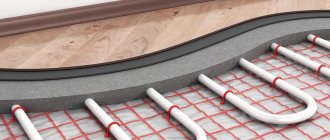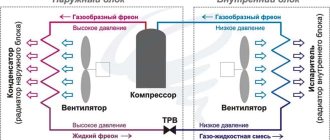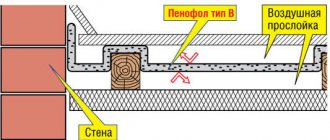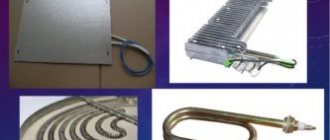Recommendations for choosing gas pipes
Most often, gas pipelines for honest houses and apartments are equipped with metal products. Steel pipes for gas supply are characterized by their ability to withstand internal pressure well. Such a pipeline is completely sealed, which reduces the risk of gas leakage to zero. When choosing steel pipes for gas pipelines, it is necessary to take into account the pressure in the gas main.
Conditions in gas pipelines may be as follows:
What kind of pipes are used for the gas pipeline? The use of thin-walled metal pipes is permitted only on low-pressure gas pipelines. This material is extremely light in weight, which makes it possible to construct systems with complex configurations from it. Also, thin-walled metal pipes are distinguished by good flexibility: if you need to give such a product a small angle, you can do without a pipe bender, doing everything by hand.
If necessary, such a gas pipeline can be easily soldered. In addition, special connecting fittings can be used for steel threaded pipes. To connect bell-shaped thin-walled elements, only sealing hemp fiber is used.
Why are VGP pipes so common?
These products are made from steel alloys. Therefore, it has a number of undeniable advantages over polymer pipes, even if the latter are of the best quality. It is still prohibited to use polymer products in some cases. For example, this is the laying of pipelines for transporting gas and supplying it to residential and public buildings. Those. Water and gas pipes, in fact, today have no competitors in the gas supply business.
Specialized steel products are also needed when laying pipes outdoors. In this case, the pipeline is affected by a lot of negative environmental factors. This means that steel pipes again receive carte blanche over polymer products. You can find out more about the types of VGP pipes on the website. Here you can see the whole variety of pipes of this type, learn about their manufacture, classification, characteristics, etc.
Features of using different types of gas pipes
High-pressure gas pipelines are constructed exclusively using massive pipes. If increased strength requirements are imposed on the main line, the use of steel pipes without seams will be required. You should be prepared for the fact that welding such elements is a much more complex procedure than soldering thin-walled pipes. From the point of view of optimal performance, copper pipes stand out in particular: in many respects they are preferable to thick-walled steel products. In terms of reliability, both of these varieties are almost the same, but copper weighs much less. What keeps copper tubes from being widely used in everyday life is their high cost.
When using thin-walled pipes, one should take into account their high thermal conductivity, which is why condensation often occurs on their surface. To protect against corrosion, it is recommended to coat the finished gas pipeline system with several layers of oil paint. Underground gas pipelines are organized using plastic pipes, which are characterized by flexibility, elasticity and low cost. Most often these are products made of polypropylene or polyethylene. For example, polyethylene gas pipes perfectly withstand underground conditions during the gasification of private properties. If it is necessary to equip the cottage with a low-pressure gas pipeline, black polyethylene pipes are used and have the corresponding yellow marking. High pressure polyethylene pipes are not used as gas pipelines.
Gas distribution indoors is carried out using vulcanized rubber hoses that have textile reinforcement. They are not suitable for high pressure: they are usually used to connect gas stoves to cylinders or gas water heaters.
The use of flexible hoses has the following limitations:
All of the above situations are prohibited for using HDPE pipes as a gas pipeline. It would be safer to choose a thin-walled or seamless steel gas pipe.
What requirements must gas pipes meet?
The main requirements for gas transportation systems are, of course, the safety and tightness of butt joints. The basic rules for their installation are set out in SNiP 42-01-2002. The document allows the use of steel, copper or polyethylene pipes for this purpose. For steel pipes, there is an additional requirement for the chemical composition: the material must contain no more than 0.046% phosphorus, 0.056% sulfur and 0.25% carbon.
Russia occupies one of the leading places in terms of the pace of construction and the number of gas pipelines.
Ventilation and safety
When installing a geyser, an exhaust pipe must be used (read: “The nuances of installing exhaust pipes for a geyser - expert advice”). It is prohibited to use flexible corrugated aluminum pipe for these purposes. Exhaust pipes for the column can only be steel or galvanized. It is recommended to equip a geyser, like any other heating device, with fuses: they will shut off the gas supply if the flame goes out.
Features of arranging a gas pipeline in the kitchen from thin-walled metal pipes:
These standards can be used as a guide when operating both ready-made gas systems and when installing or moving gas pipelines.
Features of copper pipes
Copper elements began to be used for the installation of gas pipelines relatively recently. For this purpose, the use of cold-rolled or drawn pipes is allowed. They are subject to a number of special requirements. Thus, they must have increased strength, a minimum wall thickness of 1 mm, contain no more than 0.04% phosphorus and no less than 99.9% copper.
Copper pipes for gas supply
Advantages and disadvantages of copper pipes
The advantages of copper pipes include:
- good ductility, allowing you to lay complex lines;
- long service life reaching 100 years;
- ability to withstand high mechanical loads and exposure to chemically aggressive substances;
- simple installation technology.
At the same time, copper has high thermal conductivity, so condensation can form in the pipes. Such products are less durable than steel ones, have a higher coefficient of linear expansion and are much more expensive.
Documents regulating the use of copper pipes
The use of copper pipes is regulated by the same document as steel pipes - SP 42-102-2004. Requirements for the chemical composition of the material and its grade are presented in GOST 859-78. The geometric parameters of pipes and their mechanical properties are laid down in GOST 617-90.
Gasification standards for a private home
Before starting work, you should notify your local gas authority of what is happening. The responsibility of this organization is to provide technical conditions to determine the procedure for gasification. When technical approval is completed, an individual project is developed for the upcoming work. Permission to lay gas communications should also be obtained from representatives of the automobile inspection.
If some houses in this area are already gasified, then you only need to connect a gas pipe to the main line. In this case, the gas service is obliged to notify the operating pressure parameters in the main pipeline. This will make it possible to choose the right pipes for arranging your site. The gas supply system can be autonomous or central: it depends on which source the given area will be supplied from. Private houses can be equipped with above-ground and underground gas pipelines. Mounting and installing gas pipes on a site is not very difficult - it is usually done much faster than obtaining the appropriate permits.
When laying a gas pipeline, the following sequence should be observed:
The structure of the gas pipeline in a private house consists of the same points as a similar system in an apartment.
Entering a gas pipe into the house
| Author | Share | Rate |
| Victor Samolin |
Interesting on the topic:
Simple solutions for masking gas pipes
How to move gas pipes to a new location
Classification of gas hoses
Comments on this article
Violleta Steel gas pipes are more reliable, but they are expensive.
Therefore, we decided to use the cheapest plastic option under the ground, but we used plastic ones on top of the ground and inside the house. 01/19/2016 at 19:37
Sequence and installation rules
Installation work should be carried out according to the following rules:
Rules for laying underground gas pipelines:
If you adhere to all the above requirements and rules, you can install an underground gas pipeline yourself.
Source
Features of installation of PE gas pipes
Gas polyethylene pipes must be laid in the ground or indoors so that they are not exposed to sunlight. Communications made of polyethylene cannot be laid near chimneys and heating pipes - if overheated, the polyethylene structures “lead”, and in the event of emergency situations with the chimney, polyethylene structures can ignite.
Polyethylene communications need to be well fixed on the walls with small increments. Polyethylene is an almost ideal material for laying communications in the ground.
The most important feature of installing gas pipes is that you cannot install gas communications yourself, even if you know how to do it. Gas is a source of increased danger, and the slightest leak can lead to death.
Therefore, for installation, you should engage a specialized company with a license for installation work on laying gas communications and installing equipment. It is also desirable that, in addition to the license, the company has good reviews from your friends or Gorgaz employees. And don’t forget to coordinate the laying or replacement of the gas pipeline with Gorgaz (and be sure to approve the project).
Connection methods
Polyethylene gas pipes can be connected using press fittings, butt welding, or electrofusion welding (using thermistor couplings). Crimping or compression fittings cannot be used, as well as push-in and push-fit fittings - they provide insufficient tightness of the connection.
How to weld correctly
The most reliable and tight connection is obtained by welding using thermistor couplings. These couplings have heating elements installed inside. Two pipes are inserted into the coupling, the fitting is connected to a welding machine, the coupling itself and the pipes are heated, then cooled and polymerized. Such couplings are quite expensive. Large diameter main pipelines (more than 315 mm) are welded only in this way.
For pipes with a wall thickness of at least 5 mm, butt welding is used. The connection in this case is less reliable than when welding with thermistor couplings. The ends to be joined are trimmed evenly, cleaned, dirt removed, degreased, inserted into a special soldering iron, the joints are heated and compressed tightly.
Leave for about 10 minutes until the polyethylene polymerizes, then do not move the joint for at least another half hour until the joint has completely cooled down. There is special equipment for butt welding of large pipelines.
It is necessary to pay attention to the preparation of the welded ends - the quality of the weld depends on this.
The nuisance of choice
So, steel or plastic?
The reader can make his own choice based on the above descriptions. But it is necessary to take into account some legislative restrictions.
The use of polyethylene is not allowed:
Thus, when installing a gas pipeline within a site, it is possible to follow a simple rule: it is possible to lay polyethylene in the ground along the site; From entering the house, gas is diluted only by steel. The transition between steel and polyethylene must be located outside the house above ground level.
A caveat: alas, you won’t be able to save money and install gas from the connection point to the house yourself. All work must be carried out by a licensed construction and repair organization.
Selection of pipes for a gas pipeline
Plastic pipes can be installed in a room protected from ultraviolet radiation.
Which pipes and why are used for internal gas pipelines depends on many factors:
- Purpose – gas is supplied to the consumer with minimal pressure. When installing gas supply, you can use metal-plastic, steel and copper pipes.
- Effect of ultraviolet radiation - steel and copper products can be installed anywhere inside and outside the house. Plastic ones are sensitive to sunlight, they are located in shaded areas.
- Laying method - a steel or copper gas pipeline is laid above the ground, underground, in walls, in open areas. Plastic can only be laid underground outside the house and only in open areas indoors.
- Durability – copper ones last the longest. Steel gas pipes are susceptible to corrosion and need protection. Their service life is shorter.
- Difficulty - plastic pipes are flexible and are connected by soldering. In this way, contours of any complexity can be constructed. Steel ones need to be welded and connected through fittings. This makes gas supply difficult.
The laying of gas pipes is carried out at the expense of the home owner, so the cost must be taken into account when choosing. They consider the price of the pipeline, meter, shut-off valves, as well as the cost of installation.
Which pipes are best to use for gas?
Copper has the longest service life.
Domestic gas pipes are made of steel and copper. Bronze and brass are also found, but extremely rarely.
Both materials have the main quality for a gas pipeline: they do not allow gas to pass through at all. Options are evaluated based on the following characteristics:
- Copper does not corrode. The service life of the gas pipeline is 50–100 years. Steel is susceptible to corrosion and, with the most careful care, will not last more than 20 years.
- Copper is ductile. Small diameter tubes can be bent. Steel ones need to be welded.
- The cost of a copper pipeline is noticeably higher. The steel gas pipe has the lowest price.
Copper pipes are much nicer. They do not require periodic painting and often act as part of the kitchen interior.
Calculation
Check out their list:
Let's use the calculator kindly posted on its website by the capital's representative office of the Antonio Merloni Group, which sells gas tanks.
The use of a propane-butane mixture with a peak flow rate corresponding to a thermal power of 36 kW, with a 20-meter length of polyethylene bushing and a gas temperature of +2 C, will force us to use a bushing with a minimum internal diameter of 11 mm.
Metal-plastic pipes for gas transportation
Today, the most popular pipes for gas transportation are products made of copper and steel. They meet all established reliability and safety requirements.
Metal-plastic gas pipes are successfully used when laying underground pipelines
A metal-plastic gas pipe can be used as an alternative. Steel pipelines are difficult to install, susceptible to corrosion and require considerable maintenance costs.
Conducting gas through metal-plastic elements ensures:
- long service life;
- ease of installation and low weight of structural elements;
- good transmittance;
- economical due to the minimum number of required fittings;
- versatility and variety of sizes.
Also, the pipe (metal-plastic) for gas can be laid hidden, which allows you to install the equipment in any part of the room. Such gas pipelines can last up to half a century.
Regulations
Of course, the construction and design of gas pipelines made of steel and polyethylene pipes must be based on certain regulatory documents according to which these pipes are produced. Which ones specifically?
Polyethylene
Gas pipes made of polyethylene are produced in accordance with the requirements of GOST R 50838-2009.
Let's study the main points of the document.
Steel
For metal pipes, a pair of documents operate in parallel.
What data can be found in these standards?
GOST 3262-75
They are supplied in straight lengths from 4 to 12 meters. The length can be unmeasured, measured or a multiple of measured with an allowance for any cut equal to 5 mm.
As part of the standard, products are made both from dark steel and with a protective zinc layer.
Useful: due to the most effective protection against corrosion, galvanized pipelines are assembled on threads. To seal them on gas pipelines, FUM tape is used. At welded seams, the zinc layer is inevitably damaged.
GOST R 52079-2003
Within the framework of this standard, pipes for pipelines with enormous excess pressure are produced. The situation is clear: pumping stations must overcome the enormous loss of pressure resulting from the long length of the pipelines.
Products can be manufactured using three methods:
In general, pipes are supplied in pieces of unmeasured length from 10.5 to 12 meters; by agreement with the client, but it is possible to supply pieces of cut-to-length lengths.
GOST R 52568-2006
Types of plastic pipes for gas and their characteristics
Plastic pipes mean the entire range of polymer products. Not all of them are suitable for gas transmission. The main difference between special plastic gas pipelines is their high degree of gas impermeability.
- Polyethylene - have sufficient strength, are impermeable to gas, and resistant to chemically aggressive substances.
- Polypropylene - appeared on the market quite late, therefore they are not regulated by GOST standards. This limits their use. Officially, Gorgaz may refuse to accept a system assembled from polypropylene pipes. It is recommended to use reinforced ones.
- Polyvinyl chloride - used for organizing sewers and low pressure gas pipelines. Cheap, but they break down faster.
For gas transmission, special products with appropriate markings are produced. It is prohibited to use pipes intended for water supply or sewage disposal for gas pipelines.
Low and high pressure polyethylene pipes
Low- and high-density polyethylene have different qualities. Products made from it are used in various fields:
- LDPE is temperature sensitive. It can no longer be used below 0º C. At temperatures above +40 C, the material softens and the pipe becomes deformed. The gas and vapor permeability of LDPE is quite low, but it does not allow gas transmission. LDPE pipes are used for cold water supply and sewerage.
- HDPE is a much more rigid and durable material due to additional cross-linking. Its operating temperature range is much wider, and its gas permeability is 5 times lower than that of LDPE. Polyethylene pipes are used for gas pipeline construction, starting from category 2.
Significant parameters of HDPE pipes for gas supply:
- Low gas permeability - methane and propane molecules are very small, so a material with high permeability does not provide sufficient tightness.
- The walls of the product remain smooth throughout its entire service life. This facilitates the transfer of raw materials especially over long distances.
- The service life of plastic pipes is at least 50 years. This is much higher than their steel counterparts.
- Polyethylene does not corrode and does not need protection.
- Polymer is a dielectric. Unlike a steel pipeline, a plastic one does not accumulate electricity and does not require special maintenance.
Restrictions on use are associated with insufficient mechanical strength of the material. The gas pipeline can only be laid underground, but at a depth of no more than 1 m. Under the roadbed or other areas where the load is very high, the pipes are protected with special cases.
Polyethylene gas pipes are marked accordingly. Color – bright yellow or with yellow stripes. For a gas system use:
- PE-80 - withstand pressure of 3–6 atm, wall thickness 2–3 mm. Models are offered with SDR equal to 17.6 and 11. The latter tolerate higher pressure.
- PE-100 – designed for transmitting gas under pressure of 8–12 atm. Wall thickness – 3.5 mm. They produce PE-100 with SDR of 17.6, 11 and 9.
Diameters vary from 32 to 630 mm.
Although HDPE pipes can withstand pressures of up to 16 atm, they are not suitable for installing a category 1 gas pipeline.
PVC pipes
PVC products have many advantages. They are light, quite durable, and poorly breathable. However, their use is severely limited to a small temperature range - not lower than 0 C and not higher than +45 C.
Since the material is chemically inert, PVC pipes are used in the oil industry. However, they are not suitable for supplying oil and gas.
In private homes you can find sleeves made of corrugated PVC pipes. Their length does not exceed 2 m. However, it is impossible to construct a gas pipeline from this material: Gorgaz will legally refuse to register such a system.
Polypropylene
Whether it is possible to use polypropylene rather than polyethylene pipes for gas is a controversial issue. Compared to polyethylene, its density is lower - 0.91 g / cubic cm, which is the lowest among plastics; the material begins to soften at +140 C. On the other hand, polypropylene is harder and less susceptible to wear, is chemically inert, and is exposed only to very strong oxidizing agents, but sensitive to sun and oxygen. The latter is the biggest drawback of plastic used to make pipelines. It is compensated by adding stabilizers. A more reliable option is reinforced polypropylene pipes, since aluminum or steel foil does not allow oxygen to pass through.
The following brands are produced:
- PN 10 – designed for cold water supply. The pipes can withstand pressures of up to 10 atm, but can only withstand temperatures up to +45 C.
- PN 16 - withstands pressure up to 16 atm, the temperature of the working environment can reach +60 C. However, it is not used for gas pipelines, as it has too high gas permeability.
- PN 20 – withstands pressure up to 20 atm. Used for installation of water supply circuits.
- PN 25 – the most resistant. Acceptable parameters: pressure 25 atm. and temperature up to +95 C.
It is not recommended to use polypropylene for gas due to its high gas permeability and sensitivity to light. The material has not been tested as a base for a gas pipeline.
Range of steel pipes for gas pipelines, advantages and disadvantages
The main purpose of gas pipelines is to transport flammable mixtures classified as hazardous substances. This is the reason for the requirement to use a special material to prevent any leaks. Already at the first stages of general gasification, steel pipes were used for gas pipelines. And even modern analogues made of polymer materials have not been able to displace this material from the modern market.
Is it possible to use metal-plastic pipes for gas in an apartment or private house?
When installing gas pipelines in apartments and private houses, copper or steel pipes are traditionally used. Until recently, there was no alternative to these products in Ukraine. But now metal-plastic pipes are increasingly used for the construction of gas pipelines. In this article you will learn the main characteristics of this product, its disadvantages and advantages, installation features, and you will also be able to see its photos.
Manufacturing technology
The production of metal-polymer pipe products is strictly regulated by the approved state standard. If technological standards are observed, metal-plastic products obtain excellent performance characteristics. They do not have the disadvantages that products made of metal have.
The production of metal-polymer pipes occurs in several steps:
- The extruder extrudes the inner shell of the product.
- An aluminum layer is glued to the outer part of the resulting shell, laser welded overlapping or butt-welded.
- An outer shell is applied on top of the foil.
- The resulting layered structure is pressed.
The outer polymer layer helps protect the metal from exposure to water and air. Aluminum gives the product strength and rigidity. In this case, the inner layer serves as protection against the appearance of condensation and the destructive influence of the pipeline carrier.
Metal polymer VS metal
The use of the technology described above makes it possible to give the product good physical and mechanical properties. It is thanks to them that metal-plastic pipes are in many ways superior to their metal counterparts.
They are characterized by:
- high throughput;
- resistance to the appearance of internal deposits;
- the ability to retain its shape after bending;
- easy installation;
- excellent heat resistance;
- resistance to corrosive processes and aggressive environments.
Product labeling
Metal-plastic products can be used for laying water supply, sewerage, heating and gas supply systems.
There is an international system for labeling the products in question. It allows the consumer to obtain the maximum necessary information about the product. Understanding it is not a problem. The first thing you need to pay attention to is the type of polymer used to make the pipe.
The following encoding options are available:
- PP-AL-PP - the product is made of polypropylene;
- PE-AL-PE - material of manufacture: ordinary polyethylene;
- PERT-AL-PERT - the pipe is made from a heat-resistant type of polyethylene;
- PEX-AL-PEX - products are made of cross-linked polyethylene.
Please note that products made from cross-linked polyethylene have additional letters in their markings. They denote the method of stitching the material together. The following options exist: C - electronic, B - silane, A - pyroxide.
The diameter of pipes and their thickness are indicated by different manufacturers in different units of measurement. In most cases, this data is written in inches or millimeters.
You also need to pay attention to the nominal pressure that a particular type of product can withstand. If this indicator in the system does not exceed the factory limit, the service life of metal-polymer products reaches fifty years.
Maximum pressure is a parameter relevant for pipes used to deliver media with high temperatures.
The technical documentation for the product also lists the environments for which it can be used.
Product labeling also contains the batch number and production date. When installing pipe structures, it is necessary to provide access to the information specified in the coding. It may be useful in the future when carrying out repair work, if the need arises.
How are pipes connected?
When installing metal-polymer pipes, it is necessary to properly join them together.
For this purpose, special connecting nodes are used, such as:
- Press fittings.
- Threaded fittings.
The latter option is characterized by ease of use. To connect pipes through a threaded fitting with an O-ring, there is no need to use special tools. However, this connection method is not suitable for installing gas pipelines. At pipe junctions, the level of tightness decreases over time. Therefore, there is a high probability of gas leakage.
It is best to install the gas pipeline using units created by press fittings. Such connections are characterized by a high level of reliability. They are one-piece structures. To create them you need to use special press tools.
GOST metal-polymer products
High-quality pipe products made of metal-plastic must comply with state regulations. standard 53630-2009. The document contains the key requirements for the products in question.
They contain the following information:
- Product packaging procedure.
- Requirements for raw materials necessary for the production of products.
- Products are divided into two groups according to the specified operating pressure. For the first category, this figure is up to 0.6 MPa, and for the second - 2.5 MPa. The maximum temperature of the carrier in a pipeline made of metal-polymer pipes is allowed up to ninety-five degrees for nine thousand hours.
- Product labeling is established (discussed above).
- Depending on the diameter, structures are divided into two categories. The first includes pipes ranging in size from ten to sixty-three millimeters. The second category includes products with a diameter from seventy-five to one hundred and ten millimeters.
- Methods for supplying products are indicated. Pipes of the first category are delivered in lengths up to twelve and a half meters or in coils. In the latter case, the footage must be a multiple of one hundred. Products of the second category are supplied only in the form of pieces of different lengths.
If the structures comply with the specified GOST, they must have a certificate confirming this. Keep this in mind if you decide to buy pipes for installing a gas pipeline in a private house or apartment.
The feasibility of using metal-polymer products for gas
At the beginning of the article, we noted that metal-plastic pipes are a good alternative to metal ones. Steel structures are inferior to them in the complexity of installation and resistance to corrosion processes.
Gas pipeline design
Gas pipelines made from metal-polymer products are characterized by:
- Possibility of hidden installation. Using them, you can lay a pipeline through residential premises and install the necessary equipment anywhere in the premises.
- A wide selection of pipes of various diameters and a variety of fittings. This allows for high-quality connection with any gas equipment.
- Economical use. A small number of connecting elements are required to carry out the pipeline. Since metal-polymer pipes are able to bend while maintaining the integrity of their shape.
- Excellent throughput. The inner surface of the products is smooth and does not have any roughness.
- Light weight and easy installation compared to metal counterparts.
- Duration of operation ranging from fifty to one hundred years.
In general, metal-plastic structures are better than metal alternatives. When installing them, you need to pay special attention to the tightness of the joints and the distance from heating devices.
To install the products, minimal tools are required. Products are cut using special scissors. To create reliable and tight connections, you must use a press tool.
Watch the video:
trubtraid.ru
Categories of steel pipes and types of gas pipelines
To lay pipelines, different types of pipes for gas pipelines are used, which are divided into two categories:
In the production of both categories, the basis is carbon steel, the grades of which are specified in GOST 380-2005.
The chemical composition of the steel, as well as the type and size of the gas pipeline, are determined by the following factors:
Trunk gas pipelines transport an explosive mixture with a working pressure of about 10 MPa over long distances. Their installation is carried out from large-diameter steel pipes, the quality of which must meet the highest requirements.
How are gas pipelines classified?
A gas pipeline is an engineering structure for transporting gas. It moves through pipelines under pressure.
Gas pipes are classified by purpose - main and distribution. Main gas pipelines transport gas over long distances, the pressure in them is maintained by compressor stations. Depending on the operating pressure, they are divided into two classes.
Gas distribution network pipelines are designed to deliver gas to consumers and are classified depending on pressure (low, medium, high). High pressure networks are divided into two categories and one subcategory depending on the operating pressure.
To supply residential buildings with gas, medium pressure distribution networks are used (from 0.005 to 0.3 MPa, or from 0.05 to 3 atm).
Depending on where they are laid, gas pipes are classified as above-ground, underground, or underwater.
Which pipes are suitable for carrying and supplying gas?
Pipes made of steel (carbon “black”, stainless), copper, plastic, and metal-plastic are suitable for laying gas communications. The choice of material largely depends on the conditions of laying the gas pipeline:
- Laying - external or underground.
- Depth of communication in the ground.
- Seismic hazard of the area.
- Operating pressure.
In household networks, the pressure does not exceed 0.6 MPa, or 6 atm. Plastic pipes can easily withstand this parameter.
Comparison of metal and polyethylene pipes
Plastic structures are inferior to metal in strength, so plastic and metal-plastic are not used in networks with high pressure. The big advantage of polyethylene pipes is their resistance to corrosion, which ensures a long service life - twice as long as that of steel.
When laying pipelines, plastic is used only if the pressure in the network does not exceed 1.6 MPa, otherwise steel must be used.
Polyethylene is ideal for underground gas communications - it does not rust, does not need to be painted, or additionally waterproofed. Installation of steel communications in the ground is much more complicated than installation of polyethylene ones - steel must be welded from measured pieces, painted, coated with bitumen, and wrapped in roofing felt.
Such a pipeline is additionally protected from stray currents and electrochemical corrosion, while polyethylene does not deteriorate in any way from current in the ground. Polyethylene communications are laid in the ground on a sand cushion in one large piece without insulation, which saves labor costs.
In industrial premises and buildings, steel pipes are used - they are stronger, more vandal-resistant, and more resistant to heat and fire. Although there is no direct ban on the use of polyethylene.
Metal pipelines, especially copper or stainless steel, are much more expensive than polyethylene ones.
Steel pipes are much more difficult to install - they are heavier, cut and bend with greater force, and are much more difficult to weld.
In general, if it is possible to replace a metal gas pipeline with a polyethylene one, replace it - you will not regret your choice.
Comparison of plastic and metal-plastic pipes
Metal-plastic pipes - reinforced with thin aluminum foil or durable metal mesh. Reinforcement, especially mesh, gives additional strength and reduces expansion (elongation) when heated.
In addition, foil reduces the permeability of plastic to gases. True, this value can only be significant indoors - with outdoor installation, microscopic amounts of methane and ethane leaking through the walls will not harm nature and will not cause global warming.
And in the house, the diffusion of gases through plastic is not detected even by a gas analyzer - after all, the thickness of the pipe walls was calculated by the designers.
But reinforcement reduces the flexibility of the HDPE pipe, which complicates its installation. The flexibility of reinforced pipes made of PP and PVC also decreases, but they themselves are not very flexible. There is no point in pursuing the use of metal-plastic - there is no noticeable improvement in quality, and the installation of HDPE pipelines will become more complicated. And you'll spend more money.
Documents regulating the assortment
GOST 3265-75 regulates the production of water and gas pipes. These pipes are used in the assembly of distribution systems for the supply of natural gas with an operating pressure of no more than 1.6 MPa. The diameter of such pipes does not exceed 15 cm, the length ranges from 4 to 12 meters.
GOST 8734-75 specifies the range of seamless cold-formed pipes. They are designed to operate under a pressure of 10 MPa. According to the document, pipes can have an outer diameter of no more than 25 cm and a length from 4.5 to 9 meters.
According to GOST 8732-78, you can select seamless hot-deformed pipe products. The document regulates the following pipe parameters: outer diameter size no more than 55 cm, wall thickness up to 7.5 cm, length from 4 to 12.5 meters. It is possible to install such pipes on main pipelines operating under high pressure.
What types of pipes are there?
Now, knowing what gas supply systems can be, we should move on to considering their individual components - pipes. Gas pipes were previously represented by only one material – steel. Today, as already noted, the industry also produces polyethylene gas pipes. At the same time, in terms of their performance characteristics, they are not much inferior to metal ones.
Review of polyethylene products
Gas pipes on the site, made of plastic, are characterized by a high degree of resistance to various precipitation. In addition, in chemical terms they also show excellent stability.
Plastic household products are quite durable. Therefore, they can easily be used in open areas and even in very harsh climatic conditions. They are able to retain all their positive qualities even at very low temperatures - down to -60 degrees.
Another great advantage of plastic is that it is not afraid of stray currents, since polyethylene itself is not a conductor.
Among other things, it should be noted that all polyethylene pipes do not need any additional protection, since they are not afraid of moisture, unlike steel products.
Polyethylene gas pipes
Another important advantage is the cost. It is practically no different from the cost of steel products.
Important! With all these positive qualities, it is recommended to lay only metal pipes in the house itself, but polyethylene pipes can also be laid in the ground.
In general, the restrictions on the use of these products are as follows:
- It is not recommended to use polyethylene in areas where temperatures may drop below 45 degrees;
- You cannot lay plastic products in areas where seismic activity can reach more than 6 points;
- Also, plastic is not used within the city, where the main gas pipeline belongs to the first or second category, that is, it has very high pressure;
- Such products are not used for installing pipelines underground and on the ground, as well as inside the house, as already mentioned, inside tunnels and collectors.
In all these cases, it is possible to use only steel pipes.
Steel products
It’s worth saying right away that all steel materials are subject to electrochemical and anti-corrosion treatment. This will significantly increase their service life. Due to this, the cost of the entire structure increases significantly compared to the cost of a structure made of plastic elements.
Steel gas pipes
It must be said that such materials have their own classification, since they have been produced for a very long time. First of all, the division into types is carried out according to the presence of welds:
- Welded;
- Seamless.
All such materials can be made from a mixture of low carbon steel and high quality structural steel. Among other things, the following additives are present:
- Sulfur, about 0.056%;
- Phosphorus, about 0.25%;
- Carbon, about 0.046%.
GOST establishes that the wall must have a minimum thickness of about 3 mm if we are talking about materials that are intended for underground work, and at least 2 mm for those materials that are intended for above-ground work or work inside the house.
From this point of view, the following important characteristics can be identified:
- Wall thickness;
- Nominal diameter;
- The diameter of the gas pipe or the sum of the first two parameters.
Gas pipeline on site
So, steel pipes, like plastic ones, depending on the pressure they can withstand, can be divided into three categories:
- For laying under the ground with a working pressure of up to 1.2 MPa. In this case, the outside air temperature can reach -30 degrees;
- For work above ground with operating pressure up to 1.2 MPa. In this case, the outside air temperature should not be lower than -10 degrees;
- For installation inside the house with a working pressure of up to 0.3 MPa. Moreover, the outer diameter of such products does not exceed 15.9 cm. The wall thickness is about 5 mm. The temperature of the product during operation should not be below 0 degrees.
It should be noted that all gas pipes must undergo anti-corrosion treatment. In most cases, this treatment consists of painting it in a characteristic bright yellow color.
Rules for installing steel gas pipes
It is recommended to assemble gas pipeline systems in accordance with established rules:
Pipes used for gas pipelines that are planned to be laid in the ground must use special factory-produced insulation. The technological process of its manufacture has its own characteristics, which makes it impossible to carry out such work on the construction site. In accordance with the ground conditions, the insulating coating can be of a regular or reinforced design.
Source
Advantages of the pipe
Metal plastic is absolutely resistant to corrosion processes. This property is important when transporting water, when the product is constantly in direct contact with it.
In addition, metal-plastic pipes are characterized by high throughput, which is achieved by the smoothness of the internal coating. Typically this layer is made of high-density polyethylene, which is capable of not losing its properties when exposed to hot water.
Note! If a metal-plastic pipe is connected to a metal section, then it is recommended to install special filters at the joints. This solution will prevent rust or other debris from getting from the old water supply into the new one.
The aluminum layer of the products provides good strength indicators, which are much superior to those of polyethylene or polypropylene models. Metal-plastic pipes are resistant to high temperatures, so it is possible to organize a heating system and hot water supply network on their basis. Other important advantages of such products are environmental friendliness, lightness and affordability.
